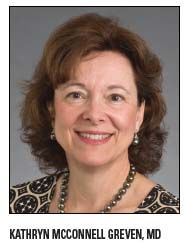Oncologists need to play a role in public education on HPV vaccination
With the increased use of human papillomavirus vaccines such as Gardasil and Cervarix, the medical community is likely to see a decrease in cases of genital warts and other complications caused by several HPV strains. But it may be a decade or two before oncologists can expect to see a decline in cervical cancer rates attributable to the use of these relatively new vaccines.
With the increased use of human papillomavirus vaccines such as Gardasil and Cervarix, the medical community is likely to see a decrease in cases of genital warts and other complications caused by several HPV strains. But it may be a decade or two before oncologists can expect to see a decline in cervical cancer rates attributable to the use of these relatively new vaccines.
"We could see some changes in the rates of precancers due to the vaccines in five to 10 years if there is high universal vaccine coverage in five years," said Lauri Markowitz, MD, a medical epidemiologist at the CDC in Atlanta. "However, it could be a couple of decades before we would expect to see any changes in the cancer rates."
Dr. Markowitz gave a presentation on HPV and current HPV immunization practices at the 2010 Interscience Conference on Antimicrobial Agents and Chemotherapy (ICAAC) meeting. She pointed out that 44% of age-appropriate girls in the U.S. have now received at least one dose of Gardasil and 27% have received all three doses.
On October 16, 2009, the FDA licensed Gardasil for use in boys and young men aged nine through 26 years for prevention of genital warts caused by HPV types 6 and 11. This vaccine previously had been licensed in 2006 for use in girls and young women aged nine through 26 years for prevention of HPV 6, 11, 16, and 18-related outcomes (vaginal, vulvar, and cervical precancers and cancers and genital warts).
The Advisory Committee on Immunization Practices (ACIP) recommended routine vaccination of girls at age 11 or 12 and catch-up vaccination for girls and young women aged 13 through 26 years. On October 21, 2009, ACIP provided guidance that Gardasil may be given to boys and young men aged nine through 26 years to reduce their likelihood of acquiring and/or passing on genital warts. However, ACIP did not recommend routine delivery of Gardasil for boys.
When Cervarix was licensed in the U. S. in October 2009, ACIP recommended that either Gardasil or Cervarix be used for routine and catch-up vaccination of girls and young women. Cervarix is the second HPV vaccine to be licensed for such use in the U.S. and it is recommended for girls and young women aged 9 through 26 years.

Today, there are many barriers to using these vaccines universally, so it is the job of the oncologist to know how they are used and what the potential benefits may be. There is a great deal of misinformation circulating about these vaccines and there is a significant gap in education, she said.
"Oncologists are not the vaccine deliverers, so it is mainly pediatricians and family practice doctors who are administering the vaccine to the recommended age groups. Oncologists see the end result of the infection, so they can talk about HPV and the use of these vaccines for the target age groups," Dr. Markowitz told Oncology News International. "There has been a variety of controversy around the vaccines. Some groups oppose vaccines in general and some people don’t understand the benefits of the vaccine. Also, some people think you don’t need it until you are sexually active. But the vaccine is most effective if given before exposure and before becoming sexually active."
Nearly all cervical cancers are caused by infection of the cervix from so-called high-risk HPV. Dr. Markowitz said that 54% of cervical cancers worldwide are attributed to HPV type 16 and another 16% of cervical cancers are attributed to HPV type 18. To date, 100 different types of HPV have been identified and 40 types are known to be sexually transmitted. Most HPV infections of the cervix resolve by themselves. Worldwide, cervical cancer is the second most common cancer in women.
Kathryn McConnell Greven, MD, a professor and vice-chair of radiation oncology at Wake Forest University in Winston-Salem, N.C., commented that because this type of cancer can be caused by a sexually transmitted virus, there is a stigma associated with it. That stigma may create significant barriers to universal vaccination.
Dr. Greven said oncologists should be aware of this issue and educate themselves and their colleagues about the two vaccines and their potential to lower cancer-related morbidity and mortality in the coming years.
"It is reasonable to say that oncologists don’t frequently get into the screening and prevention areas. But maybe oncologists should be more involved in educating primary care providers and the public," Dr. Greven said.